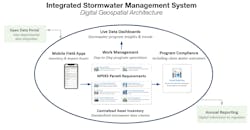The American Water Works Association (AWWA) is expanding its guidance in the stormwater arena. Since AWWA’s establishment in 1881, the association’s focus has broadened significantly, and in July 2022, AWWA introduced the first edition of its new stormwater management standard.
Stormwater runoff often represents a meaningful opportunity to enhance water supply resiliency for communities. Members of AWWA have been aware of the connection between stormwater and water supply and have recognized a need for AWWA to look at water, including stormwater, more holistically. Because of this, the association adopted a One Water approach that recognizes all water in the urban hydrologic cycle — surface water, groundwater, stormwater, and wastewater — as resources.
“We need to move away from siloed thinking to holistic thinking, from linear economy to circular economy thinking,” says Chi Ho Sham, AWWA’s immediate past president. “The One Water concept and the different perspectives of managing stormwater should be re-cast into a comprehensive and integrated water management framework.”
Developed for Water Utilities
To support the growing movement toward integrated water resource management, an AWWA standards committee (under the Standards Council — one of the six councils supported by volunteers in the water community) was established in 2016.
With inputs from experts and interested parties, the first edition of the stormwater management standard, “Stormwater Management for Water Utilities” was published in July 2022. Also known as “AWWA G560” where G denotes the series of standards on utility management, the standard represents a consensus of the water professionals on general stormwater management requirements and best practices that utilities should strive to achieve.
In part, the standards build upon the basic tenets of stormwater management found in the Urban Storm Drainage Criteria Manual, which was published by the Mile High Flood District in Denver and adopted by many other entities, such as the American Society of Civil Engineers.
AWWA’s stormwater management standard committee has focused its new management standard on water utilities. Its goal is for the standard to serve as a living document that will be expanded over time to include more detail, other water management organizations, and case studies.
While AWWA G560 is the first AWWA standard devoted entirely to stormwater, AWWA has long considered stormwater an issue that requires attention for source water protection and water quality impacts. For example, the group developed an earlier publication, “Communicating Water’s Value Part 2: Stormwater, Wastewater, and Watersheds.” The group has also addressed stormwater as it relates to asset management and water resources planning.
The new standard expands on these issues and provides more comprehensive AWWA guidance on stormwater in one source.
Varying Management Concerns
In addition, stormwater in some urban areas can mix with sanitary wastewater (in combined sewers) or be conveyed in separate systems (municipal separate storm sewer systems, or MS4s), which can result in significant differences in water quality and microbial concerns. Therefore, different approaches and management practices should be evaluated and deployed to protect source water quality.
In other words, a central role in managing stormwater is coordination with programs outside of the drinking water community to tackle local issues that would impact the operation of the drinking water utility.
Apart from the impacts on water quality, stormwater from urban areas is frequently associated with quantity issues such as flood flows causing property damage and/or loss of life, channel erosion, habitat destruction, altered base flow conditions, etc.
Grading, soil compaction, channelization, and increased impervious area can alter hydrologic regimes, speeding up flows in streets and storm drains, changing stream morphology and degrading aquatic habitats. Furthermore, increased stormflow can affect water quality through channel erosion and can mobilize contaminants in sediment and on land surfaces.
What the Standard Covers
The purpose of AWWA G560 is to define the recommended minimum requirements for a water utility to develop an integrated stormwater management system, including the management of stormwater on water utility properties, addressing water quality and water quantity issues, the planning and design of stormwater programs, and the incorporation of stormwater in integrated water resource planning and management.
A Long-Term Endeavor
Since the management of stormwater involves many different technical and non-technical issues, water utilities should anticipate that stormwater planning, permitting, design, and other implementation or operation will require many years for “ramping up” and for ongoing program operations. Utilities also should recognize that stormwater programs and facilities will need to be adequately financed.
A water utility should revisit its program periodically to consider needed program improvements due to changing conditions such as climate change, court decisions, regulatory changes, public reaction, new technologies, and other factors. The utility should demonstrate meaningful progress in the various aspects of its stormwater management program through monitoring and routine evaluation of program performance outcomes.
How to Get Involved
AWWA has plans to officially revise or reaffirm the AWWA G560 every five years — but, in the meantime, the work of the committee will continue.
Interdisciplinary and cross-disciplinary approaches are essential to develop and deploy management practices on stormwater. The association’s stormwater management standard committee is looking for participants among professionals with technical knowledge in hydrology, hydrogeology, fluvial geomorphology, hydrometeorology, hydraulics, water resources planning, landscape ecology, soil science, forestry, land use planning, education and communication, decision support systems, and program evaluation, among other disciplines. Interested professionals can contact Frank Kurtz, AWWA standards engineer ([email protected]).
AWWA’s Stormwater Management Standard Committee
AWWA Immediate Past President Chi Ho Sham served as Chair of the stormwater management standard committee alongside Jonathan Jones as Vice Chair. Other committee members included Seth Brown, Scott Deitche, Dennis Mason, Haley Rogers, Gary Conley, Neil Grigg, Frank Kurtz, Robert Pitt, Peter Rogers, Jonathan Gano, Cody Hudson, Hondo Judd, Errin Kemper, and Irene McSweeney.
Published in Stormwater magazine, November 2022.








